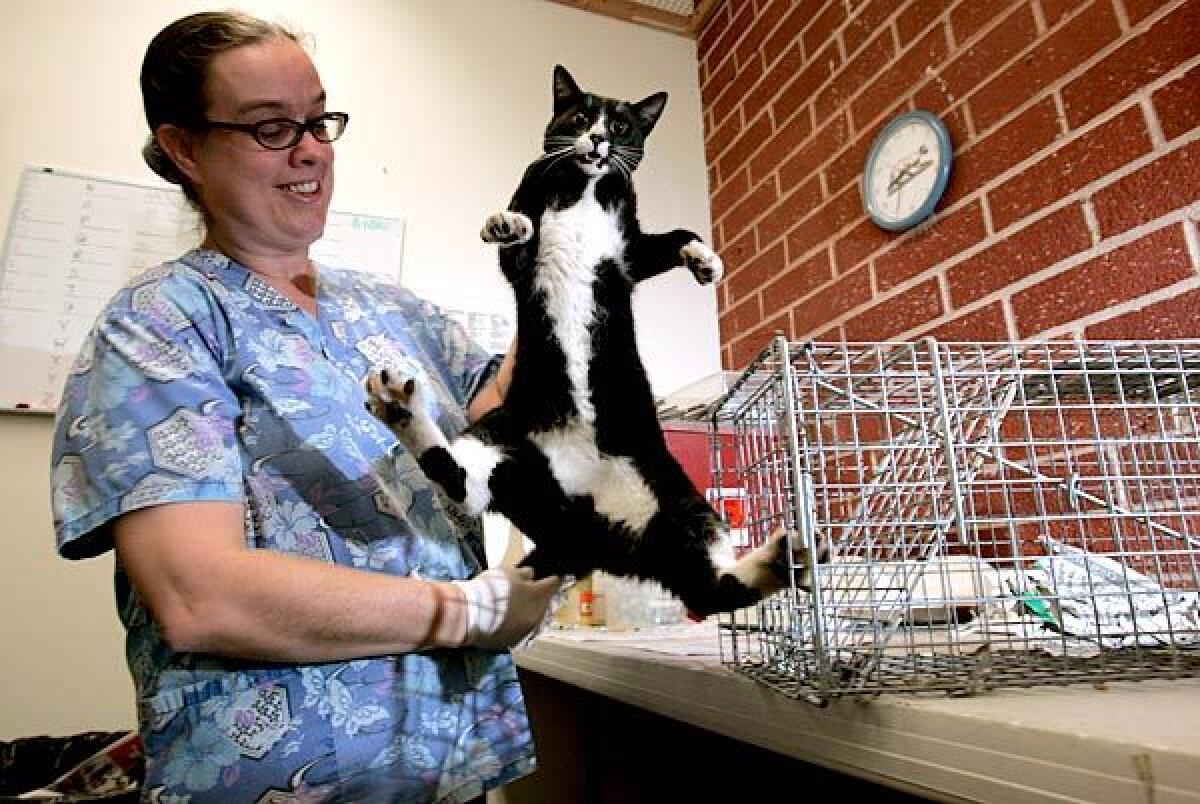A catfight over neutering program

The line forms even before the doors open at FixNation in Sun Valley. The trappers come, five days a week, back seats and trunks loaded with feral cats. Inside is a highly organized production line: On an average day, about 80 cats will be neutered, then released 24 hours later into the neighborhoods they came from.
This largely volunteer effort seeks to control a problem that vexes cities everywhere: how to manage homeless, free-roaming cats -- thought to number at least 1 million in Los Angeles -- while trying to avoid euthanizing them.
But the Audubon Society and other bird and wildlife groups say the program violates state environment laws. And what’s more, they contend it isn’t reducing the number of feral cats, which prey on many types of birds.
So the bird people took the city to court, much to the dismay of the cat people. Last month, after a daylong trial, a Los Angeles Superior Court judge sided with the plaintiffs, and it recently issued an injunction barring the city from subsidizing or promoting the trap-neuter-release program until environmental studies are completed.
In the long-playing Sylvester-vs.-Tweety battles, score a big one for the birds.
“The latest estimates are that there are about . . . 160 million feral cats [nationwide],” said Steve Holmer, senior policy advisor of the American Bird Conservancy, one of the groups that sued the city of Los Angeles. “It’s conservatively estimated that they kill about 500 million birds a year.”
But Judge Thomas McKnew Jr.’s decision sent a chill through cat advocates, who fear it could discourage municipalities across the nation from employing trap-neuter-release as a way to reduce shelter killings.
“There will be diminished public awareness of the homeless cat situation and the trap-neuter-release solution,” said Mark Dodge, founder of the nonprofit FixNation. “More homeless cats get abandoned, get ignored. It will probably mean more euthanasias of cats in shelters.”
In addition to barring city vouchers that offset the cost of neutering, the city cannot release feral cats from shelters to organizations like FixNation; conduct public outreach about the program; refer complaints about feral cats to trap-neuter-release groups; or waive cat-trap rental fees. (In the last fiscal year, the city spent about $240,000 subsidizing 8,000 surgeries for stray cats.)
City animal control officials declined to comment. The deputy city attorney on the case did not return repeated phone calls.
Not surprisingly, the ruling set off a flurry of emotional rhetoric.
In one online petition expressing outrage over the “ill-advised ruling,” signer Joanna Milkowski quoted Gandhi: “A nation’s greatness is measured by how it treats its weakest members.” Another called on people to “Help the Babies!!!!”
Dodge even suggested that these bird groups are “extremists” who “need to be marginalized” just like “Islamic jihadists.”
“It’s ugly; it’s gotten very vicious,” said Travis Longcore of the Urban Wildlands Group, one of the organizations that sued the city on behalf of the birds. “It’s not like we’ve got a vendetta here. This is a real environmental issue, a real public health issue.”
Although neutering and releasing the cats “appeals to the illusion of a win-win situation,” Longcore said, the birds and other wildlife are losing out. “The fact is, you decide not to kill cats and instead you kill wildlife.”
Those cats, Longcore said, often are diseased. And when colonies are fed, the practice often attracts more cats, either from around the neighborhood or because people dump new cats.
At San Pedro’s Cabrillo Beach, a feral cat colony resides near where snowy plovers nest, said Garry George, conservation chairman for the Los Angeles Audubon Society. At San Francisco’s Golden Gate Park, George said, feral cats have wiped out the California quail population. And in San Diego, feral cats roam free near a habitat for the California least tern, which officials are trying to monitor and protect, he said.
But even if environmental reviews are conducted, the question at the core of the dispute would remain: Does neutering feral cats effectively reduce their numbers?
Longcore, in a paper published in the scientific journal Conservation Biology, suggests that it does not, making him a prime target for cat lovers.
He cited two studies, including one in the Journal of the American Veterinary Medical Assn., that used mathematical models to determine that 71% to 94% of the cats in a colony must be neutered in order for the numbers to decline. In two feral colonies monitored in Florida, Longcore reported, the population actually increased because people dumped new cats.
In Los Angeles County, the environmental health department said that the approach has been “collectively ineffectual” and that all county-monitored colonies had significantly increased in number. Gail VanGordon, chief of the county’s vector management program, said that in addition to colonies not being reduced or eliminated, feral cats create public health concerns that result from feces and fleas.
But inside FixNation, the dedicated army of cat lovers is convinced its work is making a difference. Last year alone, the organization -- one of several in Southern California -- neutered 15,660 feral cats.
Trap-neuter-release advocates say it’s common sense: Isn’t it better to neuter those cats than to have them out breeding?
“This program has been a boon to animal control folks because it helps them manage an issue in a way that the community approves,” said Francis Battista, founder of Best Friends Animal Society, which helps fund FixNation. “If you take feral cats to a shelter, they’re dead. Nobody’s going to adopt it.”
That’s part of what drives Roberta Garten, one of FixNation’s “master trappers.”
She roams the streets of Los Angeles at night in search of feral cats. Armed with a flashlight and a Honda full of a cat’s delights -- canned tuna, desiccated fish flakes, sardines, dry kibble and catnip -- she might trap 16 to 20 animals a week. In one two-block radius in Lincoln Heights, she helped trap and fix more than 40 feral cats.
Residents, several of whom feed the feral cats, come outside to help, thanking Garten for her efforts. She’s so tuned in to the neighborhoods where she traps that she recognizes each hiding space and kitty, including one particularly stubborn black cat that had been successfully evading her traps and stinky fish.
After a long, cold night of waiting, one curious cat finally wanders into the cage. Garten checks the cat’s right ear. It’s not snipped, the telltale sign that it hasn’t been neutered -- eliciting a “hallelujah” cry of success from Garten.
“I feel like I’m doing something worthwhile,” Garten said. “I feel like it’s helping this neighborhood a lot.”
More to Read
Sign up for Essential California
The most important California stories and recommendations in your inbox every morning.
You may occasionally receive promotional content from the Los Angeles Times.











